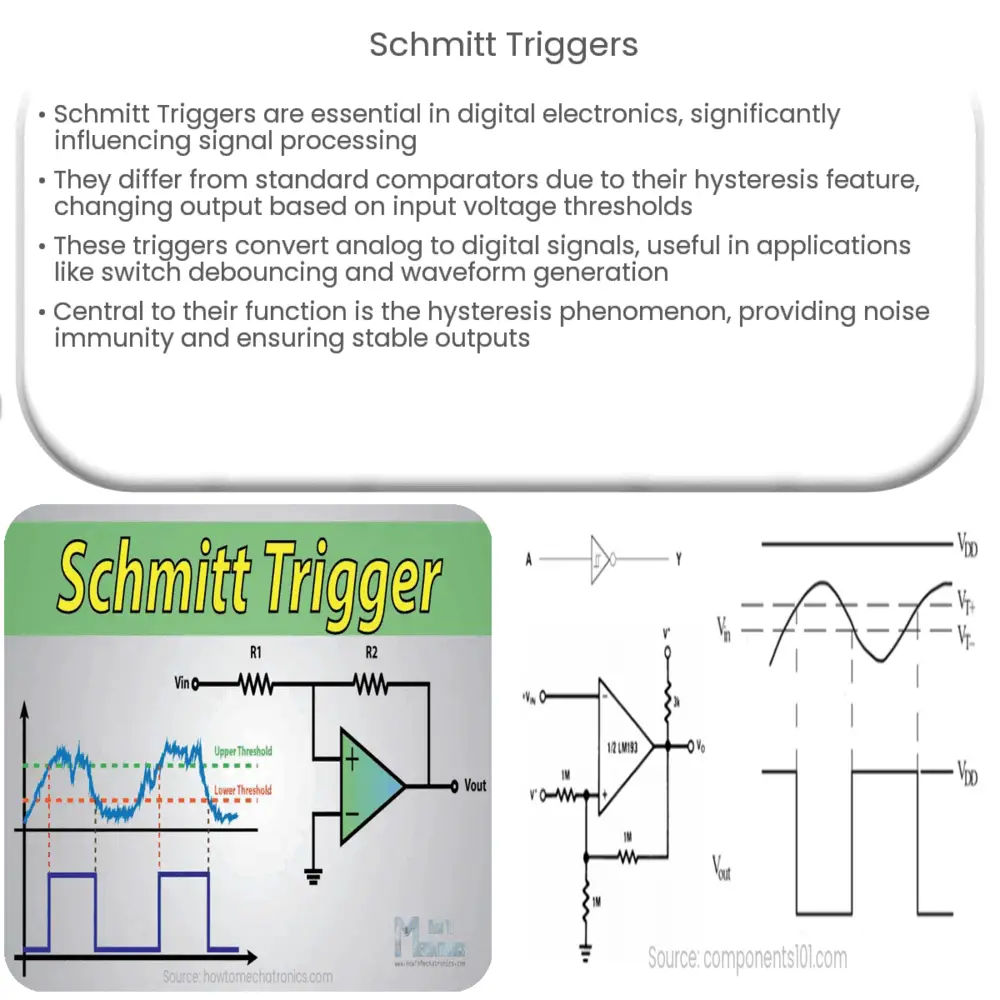Explore the basics of Schmitt Triggers, their structure, working principle, and diverse applications in digital electronics.

Schmitt Triggers: A Comprehensive Overview
Schmitt Triggers are fundamental components in the domain of digital electronics, and they play an instrumental role in shaping the signal processing industry. This article aims to offer a comprehensive understanding of this vital electronic concept, emphasizing its underlying principles, structure, and applications.
Understanding Schmitt Triggers
A Schmitt Trigger, fundamentally, is a comparator circuit with hysteresis implemented by applying positive feedback to the non-inverting input of a comparator or differential amplifier. It’s this distinguishing feature, the hysteresis, that sets Schmitt Triggers apart from conventional comparators.
The Underlying Principle
Schmitt Triggers work on a basic yet efficient principle. It is designed to change the output levels depending on whether the input voltage is above or below specific levels called the threshold voltages. These voltages, known as the upper and lower threshold voltages, are paramount to the functionality of Schmitt Triggers. As the input voltage exceeds the upper threshold, the output becomes high, and when it drops below the lower threshold, the output becomes low.
- Upper threshold (UT): This is the minimum input voltage required for the output to switch from low to high.
- Lower threshold (LT): This is the maximum input voltage at which the output switches from high to low.
Structure of Schmitt Triggers
Schmitt Triggers are usually built using transistors or operational amplifiers. The design involves a feedback resistor and a series resistor connected between the input and output. This structure forms a positive feedback circuit, responsible for the hysteresis effect, a distinctive attribute of Schmitt Triggers. Moreover, Schmitt Triggers can be either non-inverting where the output follows the input, or inverting, where the output is inverse of the input.
Real-life Applications
Schmitt Triggers find their applications in numerous areas due to their unique ability to convert analog signals to digital, particularly in cases of noisy or erratic signals. Some of their key applications include:
- Debouncing switches: A common application of Schmitt triggers is in switch debouncing, where it smoothens an erratic signal to provide a clean transition.
- Waveform generators: Schmitt triggers can be used to generate square, triangular or sinusoidal waveforms from a periodic input signal.
- Signal conditioning: Schmitt Triggers are widely used to clean up noisy signals, converting irregular analog signals to clean digital signals.
- Level translators: In multi-voltage systems, Schmitt Triggers can function as level translators, converting signals of one voltage level to another.
- Touch-sensitive switches: These electronic components have found relevance in creating touch-sensitive switches due to their ability to handle rapidly changing inputs.
Additional Applications of Schmitt Triggers
The Hysteresis Phenomenon
Central to the function of a Schmitt Trigger is the hysteresis phenomenon. This refers to the property of the system where its state depends on its immediate history. This mechanism makes Schmitt Triggers highly immune to noise, ensuring a stable output even with fluctuating inputs. Furthermore, the width of the hysteresis loop can be adjusted, effectively allowing control over the noise threshold.
Schmitt Triggers in Integrated Circuits
In the world of integrated circuits, Schmitt Triggers are present in many logic families. They are available in many standard IC packages like the 74 series and the 4000 series. Schmitt Triggers in these ICs are used to enhance the noise immunity and to transform slowly changing input signals to fast changing, jitter free output signals.
Conclusion
In conclusion, Schmitt Triggers play a vital role in the domain of digital electronics, functioning as the backbone of many digital systems. Their unique ability to handle unstable and noisy signals makes them indispensable in a myriad of applications ranging from waveform generators to touch-sensitive switches. The hysteresis feature, coupled with their flexible structure, allows Schmitt Triggers to deliver stable and noise-immune outputs, thereby greatly enhancing the performance and reliability of electronic systems. As digital electronics continue to evolve, the utility and significance of Schmitt Triggers are only likely to increase.

